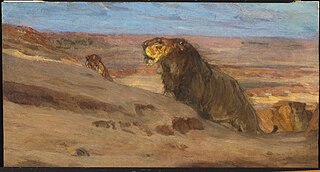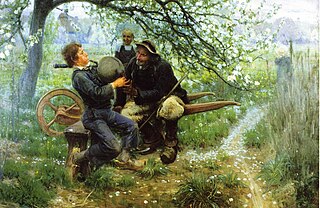
Angels have appeared in works of art since early Christian art, and they have been a popular subject for Byzantine and European paintings and sculpture.

Thomas Cowperthwait Eakins was an American realist painter, photographer, sculptor, and fine arts educator. He is widely acknowledged to be one of the most important American artists.

John Wanamaker was an American merchant and religious, civic and political figure, considered by some to be a proponent of advertising and a "pioneer in marketing". He was born in Philadelphia, Pennsylvania, and served as U.S. Postmaster General during the term of U.S. President Benjamin Harrison from 1889 to 1893.

The Annunciation, also referred to as the Annunciation to the Blessed Virgin Mary, the Annunciation of Our Lady, or the Annunciation of the Lord, is the announcement by the archangel Gabriel to Mary that she would conceive and bear a son through a virgin birth and become the mother of Jesus Christ, the Christian Messiah and Son of God, marking the Incarnation. Gabriel told Mary to name her son Immanuel, meaning "God is with us".

African-American art is a broad term describing visual art created by African Americans. The range of art they have created, and are continuing to create, over more than two centuries is as varied as the artists themselves. Some have drawn on cultural traditions in Africa, and other parts of the world, for inspiration. Others have found inspiration in traditional African-American plastic art forms, including basket weaving, pottery, quilting, woodcarving and painting, all of which are sometimes classified as "handicrafts" or "folk art".

Henry Ossawa Tanner was an American artist who spent much of his career in France. He became the first African-American painter to gain international acclaim. Tanner moved to Paris, France, in 1891 to study at the Académie Julian and gained acclaim in French artistic circles. His painting Daniel in the Lions' Den was accepted into the 1896 Salon, the official art exhibition of the Académie des Beaux-Arts in Paris. Tanner's Resurrection of Lazarus was purchased by the French government after winning the third-place medal at the 1897 Salon. In 1923, the French government elected Tanner chevalier of the Legion of Honor.
The Annunciation is the Christian celebration of the announcement by the archangel Gabriel to the virgin Mary that she would become the mother of Jesus Christ.

The Maestà, or Maestà of Duccio is an altarpiece composed of many individual paintings commissioned by the city of Siena in 1308 from the artist Duccio di Buoninsegna and is his most famous work. The front panels make up a large enthroned Madonna and Child with saints and angels, and a predella of the Childhood of Christ with prophets. The reverse has the rest of a combined cycle of the Life of the Virgin and the Life of Christ in a total of forty-three small scenes; several panels are now dispersed or lost. The base of the panel has an inscription that reads : "Holy Mother of God, be thou the cause of peace for Siena and life to Duccio because he painted thee thus." Though it took a generation for its effect to be truly felt, Duccio's Maestà set Italian painting on a course leading away from the hieratic representations of Byzantine art towards more direct presentations of reality.

The Annunciation has been one of the most frequent subjects of Christian art. Depictions of the Annunciation go back to early Christianity, with the Priscilla catacomb in Rome including the oldest known fresco of the Annunciation, dating to the 4th century.

Lions in the Desert is a painting by Henry Ossawa Tanner, painted in 1897–98 during a visit to the Middle East.

Triptych of the Annunciation is a 1483 triptych by the Flemish artist known only as the Master of the Legend of Saint Ursula, located in the Indianapolis Museum of Art, which is in Indianapolis, Indiana. It depicts the Annunciation on the central panel, while the surrounding panels and the outside of the wings are covered in various pairs of male saints.

The Young Sabot Maker is an oil-on-canvas painting made by the American artist Henry Ossawa Tanner in 1895. The painting was accepted for the 1895 Paris Salon and was Tanner's second Salon-entered painting.

The Banjo Lesson is an 1893 oil painting by African-American artist Henry Ossawa Tanner. It depicts two African-Americans in a humble domestic setting: an old black man is teaching a young boy – possibly his grandson – to play the banjo.

Anna H. Wilstach was an American art collector and museum benefactor from Philadelphia.

Atherton M. Curtis was an American art collector and a writer from Brooklyn, New York City, who settled permanently in Paris in 1903. He was also an author of introduction, art historian and publisher, who donated numerous archaeological items to the Louvre and other museums. He was also a principal benefactor of the Humane Society, and is recorded as being a strong supporter for the abolition of vivisection.

The Thankful Poor is an 1894 genre painting by the African-American painter Henry Ossawa Tanner. It depicts two African Americans praying at a table, and shares common themes with Tanner's other paintings from the 1890s including The Banjo Lesson (1893) and The Young Sabot Maker (1895). The work is based on photographs Tanner had taken, and is influenced by his views on education and race, which were in turn derived from those of his father, Benjamin Tucker Tanner, and the African Methodist Episcopal Church. The painting is considered a milestone in African-American art, notably for its countering of racial stereotypes.

The Bagpipe Lesson is a painting by Henry Ossawa Tanner, completed in late 1893 and displayed at the World's Columbian Exposition and at the Pennsylvania Academy of the Fine Arts 63rd annual exhibition, held from December 18, 1893 to February 24, 1894. The painting was begun by Tanner during his first summer in France, during a trip to Brittany. He finished the work in Philadelphia.

Sarah Elizabeth Tanner was active as a missionary worker and a religious leader in the African Methodist Episcopal Church.

Woman From the West Indies is a painting by Henry Ossawa Tanner painted about 1891 in Brittany, France, during his first or second summer in France. The portrait is unsigned but is attributed to Tanner based on the way it was painted, compared to Tanner's known works from 1891-1893. Those examining the painting looked for patterns in the way the artist used color, the brush strokes, and the stylistic choices in how light itself is shown in the painting.

Salomé is a painting by Henry Ossawa Tanner, showing the princess Salome from the Bible, who danced before her stepfather Herod Antipas, and who demanded the head of John the Baptist as a reward for her performance. Tanner painted Salome as part of his Christian-themed paintings.




















